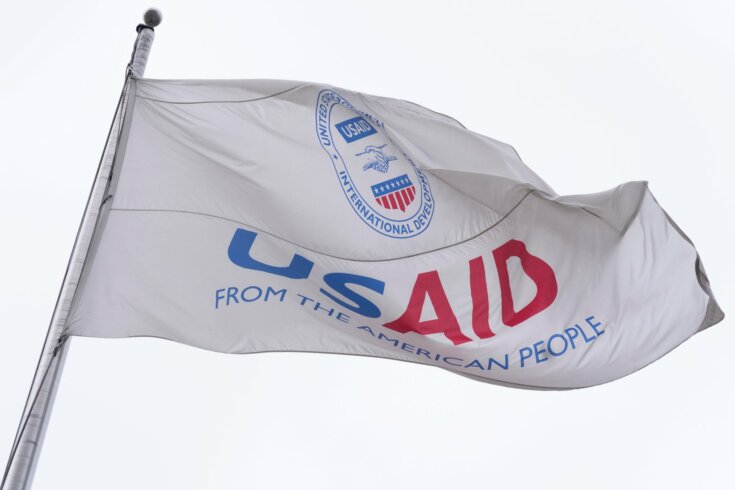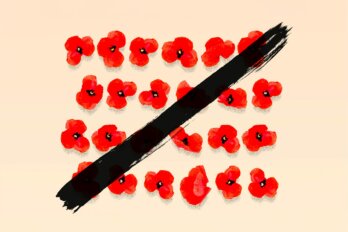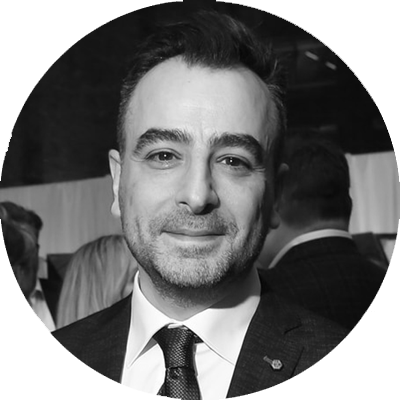O n a bitter Sunday morning in Kherson, Ukraine, the firewood deliveries stopped. The city, already plunged into darkness by recent Russian shelling, grew colder by the hour. In Kyiv, veterans and their families, desperate for support, called a crisis hotline only to be met with answering machines. Meanwhile, 4,000 kilometres south, in Egypt, struggling communities braced for longer delays in critical health care services. Just beyond, in Sudan, an already dire food security crisis deepened as vital supplies sat untouched in warehouses at the port. The thread binding these crises together? A single decision: the US Agency for International Development’s abrupt suspension of nearly all its programs.
What began on January 20 as a “90-day pause” on “new obligations and disbursements” quickly took a very different shape. Issued by President Donald Trump, the freeze reached deep into USAID’s portfolio, halting everything from humanitarian aid to long-term development projects. Staff were instructed to “support the President in achieving his vision” of an “America first” foreign policy, a directive backed by the threat of disciplinary action for those who failed to fall in line. The order imposed a gag rule, barring USAID employees from communicating outside the agency. This wasn’t just a funding decision. It was a transformation of America’s role in the world, executed not through legislation or public debate but through a cascade of memos designed to lock the bureaucracy into compliance.
As the world’s largest provider of foreign aid, the US channels most of its civilian funding through USAID. More than 60 percent of the $71.9 billion (US) allocated to foreign assistance in 2023 was handled by the agency. Established by President John F. Kennedy in 1961, USAID provides emergency relief to disaster-stricken areas and promotes development work in the Global South. These programs cost the American people less than 1 percent of their annual budget but can be life changing for recipients. From mobile health units for internally displaced people in Afghanistan to disaster-warning systems for the disabled in the Philippines, USAID’s reach cannot be overstated.
“This could not have come at a worse time,” reflects Marina Kobzeva, a lifelong aid worker and director of programmes and partnerships at MapAction, a volunteer organization that helps response teams reach affected areas through rapid mapping and data collection. “Not only is the need for humanitarian assistance growing at an exponential rate but this freeze is also coming at a time where we are losing more aid workers than ever,” she says, referring to the record-breaking number of front-line personnel killed in 2024, many of whom were targeted in conflict zones like Gaza, Sudan, and South Sudan. Loss of funding does not make aid work in crisis zones any safer.
“There are also forgotten crises, like the famine in Yemen, and emerging crises, like the aggression in eastern Congo, that don’t benefit from much media attention and are heavily reliant on the USAID,” says Kobzeva, stressing that a sudden cut-off could have devastating consequences for these regions.
Yuriy Boyechko, chief executive officer and founder of Hope for Ukraine, a humanitarian non-governmental organization, underscores USAID’s vital role. “While we do not receive USAID funding ourselves,” he says, “most of the organizations on the ground that disperse the food kits we provide to over 1,500 families and deliver our educational programs are reliant on it.”
Veteran Hub, another Ukrainian NGO, which helps veterans settling back into civilian life, has had to halt its work. “Two-thirds of our services were frozen on January 25 following the State Department’s order,” co-founder and board head Ivona Kostyna tells The Walrus. “We receive over 1,300 calls on our helpline each month, and we know for certain that we missed 240 calls in the week following the freeze,” says Kostyna.
Not all countries that receive assistance are at war, but many still face ongoing emergencies. As the CEO of an Egyptian USAID subcontractor working on “very critical improvements” to the country’s public health care system, Akmal (name changed for privacy reasons) is frustrated by setbacks caused by the stop-work order. “We have already purchased equipment,” he says. He explains that 69 percent of the population relies on public health care, “most of whom live below the poverty line.” The delays are especially concerning as they coincide with the government’s shift toward privatization.
Akmal’s organization is not the only one unable to implement services for which resources already exist. In Sudan, where the largest humanitarian crisis in the world is unfolding, bags of food gather dust at a World Food Program warehouse after the program received stop-work orders on dozens of US-funded grants. Hundreds of thousands of Sudanese children are now being left to starve. Action Against Hunger stated that they will be forced to stop treating tens of thousands of malnourished children in the Congo starting May; they also confirmed that 13,000 people in Haiti have lost access to nutritional support.
These stories, alarming as they may be, are just a glimpse into the upheaval triggered by USAID’s sweeping freeze on funding. In the weeks since the stop-work order, it has become clear that what started as a “pause” might be the end of the agency as we know it.
Caroline Shenaz Hossein worked for seventeen years in global nonprofits and consulted for USAID before becoming a Canada research chair and associate professor of global development and political economy at the University of Toronto. She predicts that the effects will be catastrophic, “particularly because there was no advance notice” to aid workers and USAID partners, allowing them no time to adjust to the loss of resources. “I’m bracing myself for the pain, suffering, and deaths coming along,” she says. “It is inevitable that people will die.”
While the stop-work order left those on the humanitarian front lines in a state of paralysis, the agency was unravelling from the inside. In the US, hundreds of staffers and affiliates—including senior officials—were laid off or furloughed within the first week of the order. Many small businesses tied to the agency’s supply chains now face closure. Some of USAID’s largest contracts to US-based contractors have been suspended or terminated, leading to mass layoffs and organizational shutdowns. Staff reported seeing the agency’s building being emptied out, with all USAID-related photos removed off its walls. They were also locked out of their work emails and devices, unable to even submit their hours in order to get paid. The biggest warning sign came on February 1, when USAID’s website abruptly went offline.
Multiple sources have confirmed that the Trump administration’s plan for USAID includes slashing its workforce from 10,000 personnel worldwide to just 294 deemed “essential.” It also aims to dissolve the agency and integrate its work into the Department of State. A federal judge, responding to a lawsuit from a labour union and the American Foreign Service Association, blocked Trump from placing 2,200 USAID staff on leave. But on February 21, the judge removed the temporary block, stating the plaintiffs could not prove that placing USAID staff on leave would cause irreparable harm to the employees. Shortly after, the administration put nearly all of USAID’s direct hires on paid administrative leave and disclosed that they will terminate 1,600 of those positions.
Although the department issued a waiver intended to keep critical aid flowing, it did little to offset the operational free fall. Instead, the waiver sparked ample confusion among aid workers and United Nations officials, who are unsure of the programs it applies to and unable to check with their US officials due to communications bans. The stop-work order, and the developments that ensued within USAID, have also meant that there are no staff left to process applications for exemption, rendering the waiver ineffective.
Behind much of the chaos is the Department of Government Efficiency, or DOGE, an agency created by Trump’s executive order on Inauguration Day to “moderniz[e] Federal technology and software” and led by Elon Musk, senior adviser to Trump and the richest man in the world. DOGE carried out the dismantling of USAID without legal authority. Two top security officials who refused to grant DOGE access to agency systems were placed on administrative leave. Both Trump and Musk took to their X accounts to lob reckless, unsubstantiated accusations against USAID, branding it “TOO DIRTY!” and an instrument of “the radical left” before declaring it was “[t]ime for it to die.”
On February 5, USAID staff and contractors, backed by Democratic lawmakers, rallied in the streets to call upon the US Congress to block DOGE’s illegal takeover of the agency. They held signs emphasizing USAID’s critical role in providing life-saving aid and spoke of its global impact, which includes combating diseases such as Ebola.
Six weeks into its suspension, Secretary of State Marco Rubio declared that they are “officially cancelling 83 percent of the programs at USAID.” The surviving approximately 1,000 or so programs will now be administered under the Department of State. Rubio also thanked DOGE for their role in achieving what he called “overdue and historic reform.” This nod of thanks, however, came shortly after the New York Times reported a “blow up” between Rubio and Musk over DOGE’s chainsaw approach towards USAID.
A number of firms with halted or cancelled USAID projects filed a lawsuit against the Trump administration, seeking compensation for work finished before the freeze took effect. On February 25, US district judge Amir Ali ordered the government to settle outstanding dues with both contractors and grant recipients by the following Wednesday. The administration quickly appealed to the Supreme Court, only for the court to uphold the judge’s decision, with a new deadline of March 10 for the payments to be made. Trump has yet to comply. The administration plans to close USAID fully by July 1.
The abrupt suspension of USAID operations and its fallout may come as a shock to many, but not to Hicham Safieddine, Canada research chair and associate professor at the University of British Columbia. According to Safieddine, who researches the global financial order, these decisions are “in line with Trump’s ideology and style of governance.”
He suggests the pause may mark a shift toward narrower goals, aimed at ensuring no money is spent “with no return for the American people,” as Trump writes in his order. Hossein also expects that Trump’s right-wing “America First” stance, combined with his business background, will usher in a more transactional style of foreign policy. “A sense of global responsibility is not something we will see with this administration. He’s more interested in making deals,” she says.
What USAID faces now is what the UK Department for International Development once faced. In 2020, as an appeal to his right-wing base, then prime minister Boris Johnson closed the department, integrated development work into the Ministry of Foreign Affairs, and slashed the country’s foreign aid budget.
This attitude toward development may soon spread amongst Western governments. “We might see copycats emulating Trump,” says Hossein, “especially in countries that are experiencing a rise in right-wing nationalism.” Kobzeva echoes this sentiment. “As aid workers, we are on our toes,” she says. “There are a few key elections coming up in Europe, and governments might feel pressure to adopt similar policies in order to win over populaces that are increasingly shifting rightwards.” The UK has already cut aid budgets, while the Netherlands has come up with a statement that they will use their foreign assistance budget for national interest, starting in 2027. Belgium also announced they will be cutting 25 percent of their assistance over the year.
Akmal, however, is not as worried. He claims that other bodies, like the Spanish Agency for International Development Cooperation, the German Agency for International Cooperation, and China International Development Cooperation Agency, have already stepped up to help.
Much like Johnson, Trump is appealing to his right-wing supporters. Despite distancing himself from Project 2025 during the presidential election, he is now adhering to it. Project 2025 is a far-right plan advanced by the Heritage Foundation that, according to its spokesperson, makes “policy and personnel recommendations for the next conservative president.” The project’s 922-page “Mandate for Leadership” dedicates an entire chapter to USAID. Max Primorac, the chapter’s author, wrote in 2023 that the US’s next conservative president should align “US foreign aid to US foreign policy” by leveraging foreign aid to “unleash the power of America’s private sector” and shrinking USAID’s humanitarian aid portfolio. It is difficult to miss that those are precisely Trump’s objectives.
The logic behind those proposals, however, contains a significant flaw. USAID and US foreign aid have never been purely altruistic; they have consistently prioritized American interests. Humanitarian aid has addressed threats like infectious diseases and terrorism before they reach US shores. The US has not always distributed aid based on need but rather where it would be most effective. Despite changing administrative priorities, foreign aid and development work have long allowed the US to forge alliances, strengthen its economy, and advance foreign policy goals through soft power, reinforcing its global position.
In fact, experts believe that the stop-work orders may create a power vacuum that Russia and China may exploit to promote their own agendas. It is for this reason that Munira (name changed for privacy reasons), director of a feminist initiative in Egypt, argues that sustainable development work needs to move away from an aid-reliant model. Munira’s project, providing digital literacy and emergency interventions for girls facing online blackmailing and harassment, was frozen with the suspension of USAID, but she says that challenges arose long before.
“We spend valuable months attuning our project proposals to donors’ standards as women in need await our services,” Munira says, “but as long as we depend on donations, we remain beholden to the donors’ agendas and demands, which are often out of tune with the local context.” The stop-work order was the last straw; Munira is determined to achieve self-reliance for her initiative. “I am now striving to establish a revenue-generating arm whose profits can service our developmental work,” she tells The Walrus.
Safieddine believes that a similar change could also happen on a larger scale. “USAID has never led to an alleviation of poverty. If anything, it reinforced relations of dependency and created short-term aid solutions to long-term developmental problems,” he explains. These dependencies are often more beneficial to the US than they are to the other nations. “We may see negative impacts in the short run, but US foreign aid reduction is ultimately a positive step, provided that developing countries replace it with well-planned, long-term development policies.”
Hossein agrees, arguing that now is an opportune time for “homegrown alternatives” to USAID. She cites the Bangladesh Rehabilitation Assistance Committee and Grameen Bank as examples of excellent development initiatives emerged in and for the Global South. “It is important to push back against a narrative that constructs countries in the Global South as hopeless, helpless, and awaiting white saviours.”





